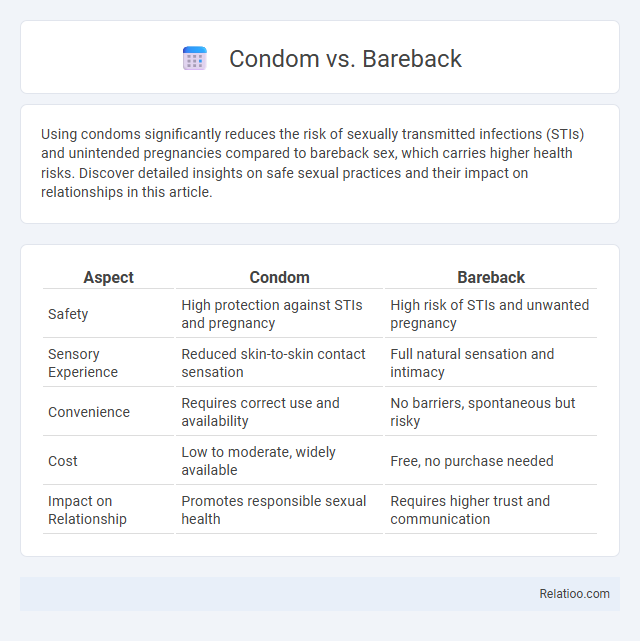Using condoms significantly reduces the risk of sexually transmitted infections (STIs) and unintended pregnancies compared to bareback sex, which carries higher health risks. Discover detailed insights on safe sexual practices and their impact on relationships in this article.
Table of Comparison
| Aspect | Condom | Bareback |
|---|---|---|
| Safety | High protection against STIs and pregnancy | High risk of STIs and unwanted pregnancy |
| Sensory Experience | Reduced skin-to-skin contact sensation | Full natural sensation and intimacy |
| Convenience | Requires correct use and availability | No barriers, spontaneous but risky |
| Cost | Low to moderate, widely available | Free, no purchase needed |
| Impact on Relationship | Promotes responsible sexual health | Requires higher trust and communication |
Understanding Condom Use in Sexual Activity
Condom use is a crucial aspect of safe sex, significantly reducing the risk of sexually transmitted infections (STIs) and unintended pregnancies. Bareback sex, or unprotected sex, increases vulnerability to HIV, herpes, gonorrhea, chlamydia, and other STIs due to the absence of barrier protection. Understanding condom choice, proper application, and consistent use enhances sexual health outcomes and promotes responsible sexual behavior.
What Is Bareback Sex?
Bareback sex refers to sexual intercourse without the use of a condom, increasing the risk of transmitting sexually transmitted infections (STIs) such as HIV, gonorrhea, and chlamydia. Unlike safe sex practices that emphasize condom use to reduce infection risks, bareback sex may prioritize physical sensation over protection. Understanding the health risks associated with bareback sex is crucial for making informed decisions about sexual health and prevention methods.
Health Risks: Condom vs. Bareback
Using a condom significantly reduces the risk of sexually transmitted infections (STIs) such as HIV, chlamydia, and gonorrhea, while bareback sex substantially increases your vulnerability to these infections due to direct skin-to-skin contact and unprotected fluid exchange. Safe sex practices emphasize consistent condom use, which also helps prevent unintended pregnancies, contrasting sharply with the higher health risks associated with bareback intercourse. By choosing condoms, your protection against pathogens is maximized, promoting overall sexual health and reducing potential long-term complications.
Protection Against STIs and HIV
Condom use provides the highest level of protection against STIs and HIV by creating a barrier that prevents the exchange of bodily fluids. Bareback sex, defined as unprotected intercourse, significantly increases the risk of transmitting infections due to direct contact with blood, semen, or vaginal fluids. Safe sex practices, including consistent condom use and routine STI testing, are essential strategies to reduce the likelihood of infection and promote sexual health.
Pregnancy Prevention Differences
Condoms provide a reliable barrier method for pregnancy prevention by physically blocking sperm from reaching the egg, offering a high level of effectiveness when used correctly. Bareback sex, or unprotected intercourse, carries a significant risk of unintended pregnancy due to the absence of any contraceptive barrier. Your best option for preventing pregnancy while maintaining sexual health is practicing safe sex, which combines condom use with other contraceptive methods to maximize protection.
Sensation and Pleasure: Myths vs. Facts
Condoms are often believed to reduce sensation and pleasure, but modern ultra-thin and textured condoms preserve sensitivity while providing effective protection against STIs and unwanted pregnancies. Bareback sex may offer heightened physical sensation but carries significant risks of infection and emotional stress, challenging the myth that pleasure is inherently better without protection. Safe sex practices, which include correct and consistent condom use, enhance trust and intimacy, debunking the misconception that safety compromises sexual satisfaction.
Consent and Communication Strategies
Condom use remains a key component in safe sex practices, significantly reducing the risk of sexually transmitted infections (STIs) and unplanned pregnancies, while bareback sex involves intentional unprotected intercourse, increasing health risks. Prioritizing consent involves open communication where partners discuss boundaries, sexual health status, and protection preferences to ensure mutual agreement and comfort. Your sexual wellbeing depends on transparent dialogue and respecting each other's choices, fostering trust and informed decisions in all encounters.
Accessibility and Convenience Factors
Condoms offer high accessibility and convenience, as they are widely available at pharmacies, stores, and online, providing a reliable barrier against sexually transmitted infections (STIs) and unplanned pregnancies. Bareback sex lacks protection, increasing risk and requiring less preparation but often compromising safety, making it a less convenient choice for those prioritizing health. Safe sex practices emphasize using condoms or other protective methods, ensuring you maintain control over your sexual health while balancing ease of use and availability.
Cultural Attitudes Toward Condom Use and Bareback
Cultural attitudes toward condom use vary widely, with some societies embracing condoms as essential tools for safe sex and sexual health, while others associate them with mistrust or reduced pleasure. Bareback sex, often viewed as risky due to the absence of barrier protection, carries stigmatization in many communities but can also symbolize trust or intimacy in certain subcultures. Safe sex campaigns consistently emphasize condom use to prevent sexually transmitted infections (STIs) and unintended pregnancies, yet cultural norms and personal beliefs significantly influence individuals' attitudes and behaviors regarding condom adoption.
Making an Informed Sexual Health Decision
Choosing between condom, bareback, and safe sex practices involves evaluating protection against sexually transmitted infections (STIs) and pregnancy risks. Condoms offer a reliable barrier method that significantly reduces STI transmission and unintended pregnancies, while bareback sex lacks this protection, increasing vulnerability. Your informed sexual health decision should prioritize consistent contraceptive use and regular STI testing to maintain wellness and safety.

Infographic: Condom vs Bareback
 relatioo.com
relatioo.com